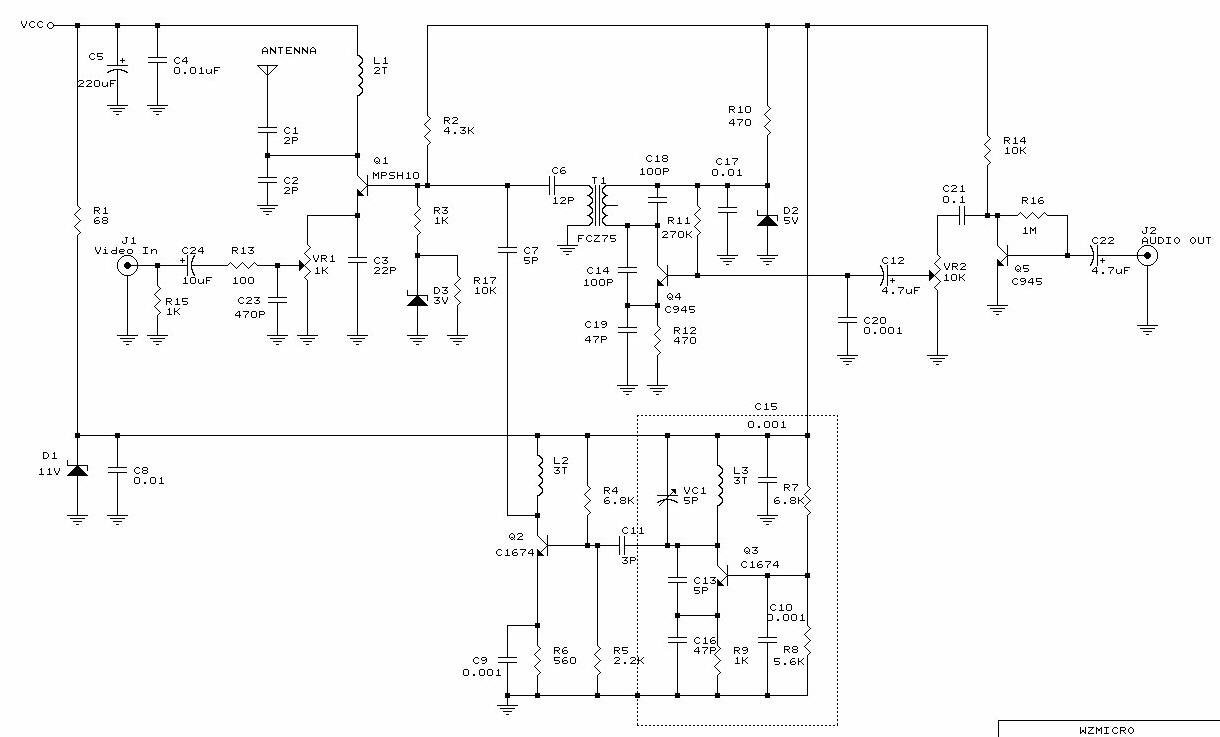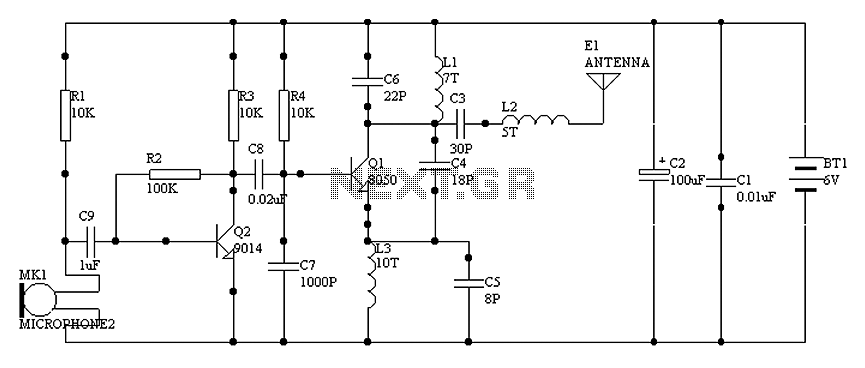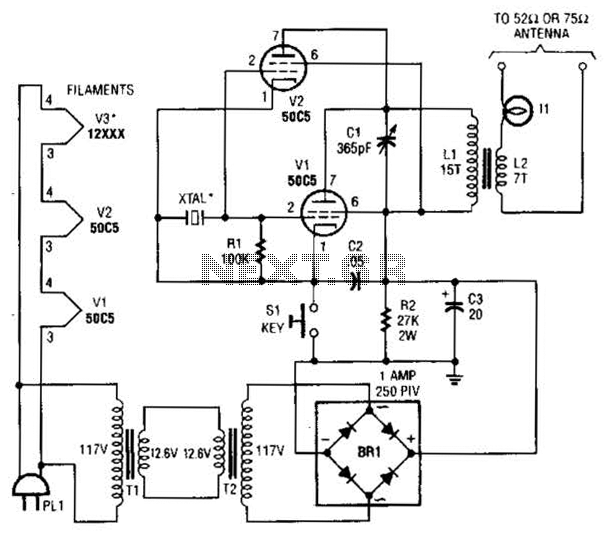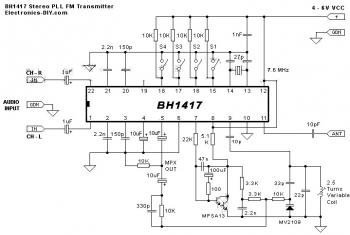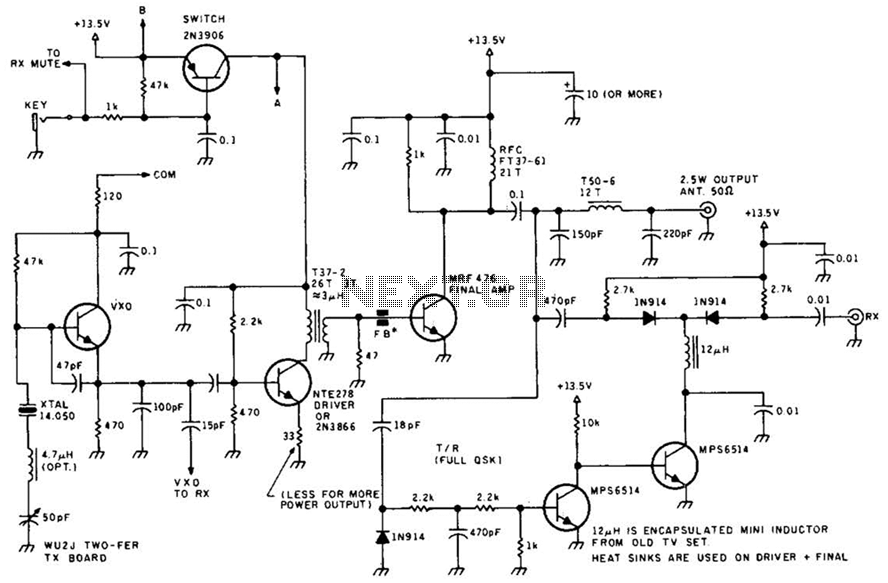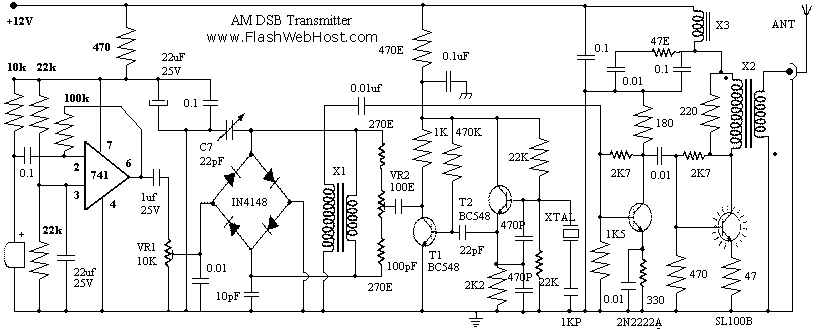
2M Transmitter
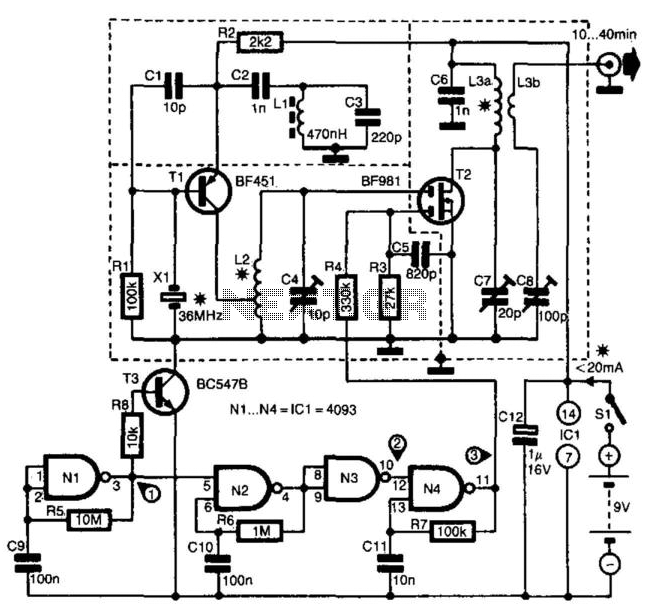
The transmitter is specifically designed for radio amateurs to function as a radio beacon, delivering a high-quality signal devoid of unwanted harmonics. Transistor T1, in conjunction with crystal X1, serves as a 36-MHz oscillator. Filter L1/C3 prevents the circuit from oscillating at 12 MHz, the crystal's fundamental frequency. Circuit L2/C4 is tuned to the fourth harmonic of the oscillator signal at 144 MHz. This signal is transmitted to the antenna through a buffer stage composed of T2, a double-gated FET. The amplitude modulating signal is applied to the second gate of the buffer. The transmitter operates at a low output power of approximately 10 to 40 mW. The modulating signal is produced by N1, an oscillator that controls the transmitter's on/off state via transistor T3. The switching frequency ranges from 0.1 to 0.5 Hz. When N1's output is low, T3 is turned off, rendering the transmitter inoperative due to the disabled supply. Conversely, when N1's output is high, T3 is activated, allowing normal transmitter operation. The digital pattern at T2's gate shapes the modulating signal. Gate N2 generates a square wave with a frequency between 0.1 and 1 Hz. While T3's output remains high, N4 oscillates at approximately 1 kHz. Consequently, a periodic burst signal at 1 kHz is present at N2's gate, which modulates the transmitter. The digital pattern at N2's gate can be adjusted according to individual requirements by changing the feedback resistor values in the digital chain. Calibration of the transmitter is achieved by adjusting trimmers C4, C7, and C8 for maximum output power. Inductors L2 and L3 are made from 0.8-mm diameter enamelled copper wire: L2 consists of 5 turns with a tap of 1 turn from ground; L3A has 3 turns, and L3B has 2 turns. The coupling between L3A and L3B should be optimized for maximum output power. The circuit consumes only 20 mA, allowing the transmitter to operate on a 9-V battery for several hours.
The transmitter circuit is structured to ensure optimal performance for amateur radio applications, with a focus on signal integrity and efficient power consumption. The oscillator stage, utilizing transistor T1 and crystal X1, is critical for generating a stable frequency of 36 MHz. The filtering elements, L1 and C3, are strategically placed to eliminate any potential interference at the fundamental frequency of 12 MHz, ensuring that only the intended harmonics are transmitted.
The tuning circuit L2/C4 is essential for aligning the output to the fourth harmonic frequency of 144 MHz, which is commonly used for radio beacons. The buffer stage, featuring the double-gated FET T2, plays a vital role in isolating the oscillator from the antenna load while allowing for modulation through the second gate. The low output power of 10 to 40 mW is adequate for beacon transmission, providing a balance between performance and battery life.
The modulating signal generated by oscillator N1 is responsible for turning the transmitter on and off, providing a pulsed output that can be easily distinguished by receiving stations. The switching behavior controlled by transistor T3 allows for a flexible modulation scheme, with a frequency range that can be adjusted based on operational needs.
The digital signal shaping at gate N2, combined with the square wave generation, results in a modulated output that can be tailored for various applications. The calibration process involving trimmers C4, C7, and C8 ensures that the transmitter operates at peak efficiency, maximizing output power while maintaining signal quality.
The construction of inductors L2 and L3 from enamelled copper wire is a practical choice, ensuring durability and reliability in the circuit. The specific winding configurations and the emphasis on coupling between L3A and L3B are critical for achieving the desired output characteristics. Overall, the design prioritizes low power consumption, allowing for extended operation from a standard 9-V battery, making it suitable for portable applications in amateur radio. The transmitter was designed specifically for use by radio amateurs as a radio beacon. As such, it provides a good-quality signal that is free of unwanted harmonics. Transistor Tl, in association with crystal XI, operates as a 36-MHz oscillator. Filter L1/C3 obviates any tendency of the circuit to oscillate at 12 MHz (the fundamental frequency of the crystal). Circuit L2/C4 is tuned to the fourth harmonic of the oscillator signal (144 MHz). This signal is fed to the aerial via a buffer stage that consists of T2, a double-gated FET. The (amplitude) modulating signal is applied to the second gate of the buffer. The output power of the transmitter has been kept low, about 10 to 40 mW. The modulating signal is generated by Nl, an oscillator that switches the transmitter on and off via transistor T3.
The switching rate lies between 0.1 and 0.5 Hz. When the output of Nl is low, T3 is switched off, and the transmitter is inoperative because the supply is disabled. When the output of Nl is high, T3 is on and the transmitter operates normally. The digital pattern at the gate of T2 shapes the modulating signal. Gate N2 generates a square wave at a frequency of 0.1 to 1 Hz. As long as the output ofT3 is high, N4 oscillates at a frequency of about 1 kHz. At the relevant gate of N2, there is, therefore, a periodic burst-signal at 1 kHz, and this signal is used to modulate the transmitter.
The digital pattern at the relevant gate of 2 can be varied to individual requirements by altering the values of the feedback resistors in the digital chain. The transmitter is calibrated by setting trimmers C4, C7, and C8 for maximum output power. Inductors L2 and L3 are wound from 0.8-mm diameter enamelled copper wire: L2 = 5 turns with a tap of 1 turn from ground; L3A = 3 turns and L3B = 2 turns.
The coupling between L3A and L3B should be arranged for maximum output power. The circuit draws a current of only 20 mA, which enables the transmitter to be operated from a 9-V battery for several hours. 🔗 External reference
The transmitter circuit is structured to ensure optimal performance for amateur radio applications, with a focus on signal integrity and efficient power consumption. The oscillator stage, utilizing transistor T1 and crystal X1, is critical for generating a stable frequency of 36 MHz. The filtering elements, L1 and C3, are strategically placed to eliminate any potential interference at the fundamental frequency of 12 MHz, ensuring that only the intended harmonics are transmitted.
The tuning circuit L2/C4 is essential for aligning the output to the fourth harmonic frequency of 144 MHz, which is commonly used for radio beacons. The buffer stage, featuring the double-gated FET T2, plays a vital role in isolating the oscillator from the antenna load while allowing for modulation through the second gate. The low output power of 10 to 40 mW is adequate for beacon transmission, providing a balance between performance and battery life.
The modulating signal generated by oscillator N1 is responsible for turning the transmitter on and off, providing a pulsed output that can be easily distinguished by receiving stations. The switching behavior controlled by transistor T3 allows for a flexible modulation scheme, with a frequency range that can be adjusted based on operational needs.
The digital signal shaping at gate N2, combined with the square wave generation, results in a modulated output that can be tailored for various applications. The calibration process involving trimmers C4, C7, and C8 ensures that the transmitter operates at peak efficiency, maximizing output power while maintaining signal quality.
The construction of inductors L2 and L3 from enamelled copper wire is a practical choice, ensuring durability and reliability in the circuit. The specific winding configurations and the emphasis on coupling between L3A and L3B are critical for achieving the desired output characteristics. Overall, the design prioritizes low power consumption, allowing for extended operation from a standard 9-V battery, making it suitable for portable applications in amateur radio. The transmitter was designed specifically for use by radio amateurs as a radio beacon. As such, it provides a good-quality signal that is free of unwanted harmonics. Transistor Tl, in association with crystal XI, operates as a 36-MHz oscillator. Filter L1/C3 obviates any tendency of the circuit to oscillate at 12 MHz (the fundamental frequency of the crystal). Circuit L2/C4 is tuned to the fourth harmonic of the oscillator signal (144 MHz). This signal is fed to the aerial via a buffer stage that consists of T2, a double-gated FET. The (amplitude) modulating signal is applied to the second gate of the buffer. The output power of the transmitter has been kept low, about 10 to 40 mW. The modulating signal is generated by Nl, an oscillator that switches the transmitter on and off via transistor T3.
The switching rate lies between 0.1 and 0.5 Hz. When the output of Nl is low, T3 is switched off, and the transmitter is inoperative because the supply is disabled. When the output of Nl is high, T3 is on and the transmitter operates normally. The digital pattern at the gate of T2 shapes the modulating signal. Gate N2 generates a square wave at a frequency of 0.1 to 1 Hz. As long as the output ofT3 is high, N4 oscillates at a frequency of about 1 kHz. At the relevant gate of N2, there is, therefore, a periodic burst-signal at 1 kHz, and this signal is used to modulate the transmitter.
The digital pattern at the relevant gate of 2 can be varied to individual requirements by altering the values of the feedback resistors in the digital chain. The transmitter is calibrated by setting trimmers C4, C7, and C8 for maximum output power. Inductors L2 and L3 are wound from 0.8-mm diameter enamelled copper wire: L2 = 5 turns with a tap of 1 turn from ground; L3A = 3 turns and L3B = 2 turns.
The coupling between L3A and L3B should be arranged for maximum output power. The circuit draws a current of only 20 mA, which enables the transmitter to be operated from a 9-V battery for several hours. 🔗 External reference
